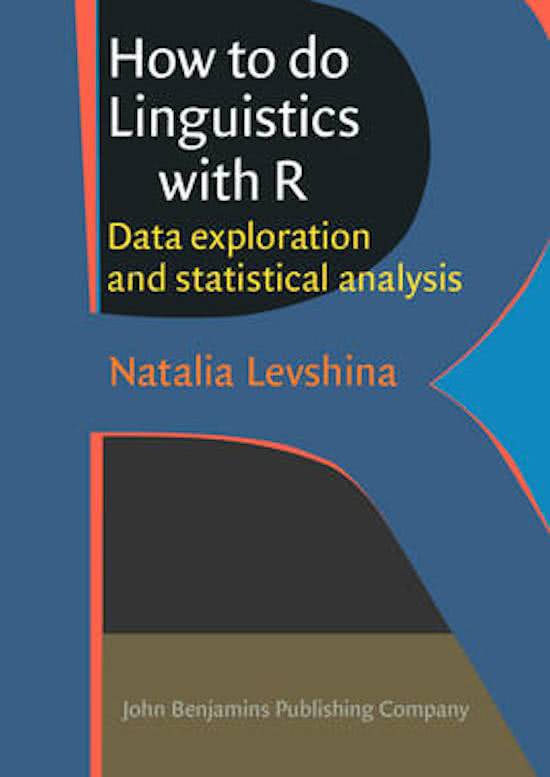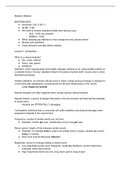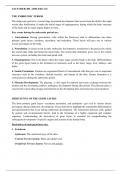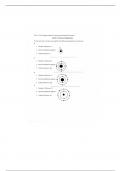p>0.05 = not significant – accept null – p is big
p<0.05 = significant – reject null – p is small
Week one: 1-Way ANOVA
Comparing means of groups: Do two groups have the same population
mean? We can use a t test and find out with its p-value
Example: is there difference in the effectiveness between two methods for
reading lessons for second-graders?
Do three or more groups have the same population mean? We can use
ANOVA
1-way ANOVA can be used for this type of question:
• Do three or more groups have the same population mean and are
the populations classified according to one factor?
o Eg: Is there a difference in the effectiveness between three
methods for reading lessons for second-graders?
o Using multiple t-tests, comparing 3 groups but that is not ideal
Issue with multiple t-tests: inflation of surprise
• When one performs multiple comparisons on the same data, the
probability of finding a surprising result increases --- change of type
I error increases
Consider 3 groups: A, B, C. We have 3 pairwise comparisons: (A, B), (A, C), (B,
C)
• p<0.05, so probability of no Type I error: 95% -- 5% chance of false
positive
• Each test is independent, so for 3 groups so you have to run 3 t-tests
o Probability of no Type I: 0.95*0.95*0.95 = 0.857
o Probability of Type I error is 1-0.857 = 14.3% -- much higher than
5%
Why we use ANOVA instead
___________________________________
ANOVA stands for ANalysis Of VAriance
• The name refers to variance, yet this technique is about comparing
the means (of 3 or more groups)
, • Predictor variable(s) are categorical factors (in 1 way ANOVA, 1
predictor)
• ANOVA is a family of statistical tests.
• 3 types:
1. 1-way
i. Observations are independent
ii. 1 experiment condition
2. Factorial
i. Observations are independent
ii. 2 or more experimental conditions. We can measure:
1. Individual effects
2. interactions
3. Repeated measures
i. Each subject is tested more than once, or
ii. Each stimulus is presented more than once
Variable types
• Between-group: different groups or subjects assigned to different
conditions
o Eg: patients taking 3 different treatments
• Within-subject: the same subjects tested in more than 1 condition
o Eg: subjects reacting to 3 different types of words (each
subject sees all the types)
What this implies?
• Only between-group variables: 1-way and factorial ANOVAs
• Only within-subject: repeated measures ANOVA
• Both types: mixed ANOVA (not covered in course)
~ ANOVA is a special case of linear regression (LR). In fact R implements
ANOVA as LR
• everything you can do with ANOVA you can do with regression
~ ANOVA is in disuse in favour of LR
• Still, you will find ANOVAs in papers so you should be able to
interpret them
Assumptions:
• The observations are independent from each other
• The response variable is at least interval-scaled
o Its numerical
,• The residuals are normally distributed (each sample is drawn from a
normally distributed population)
o
▪ We see if the residuals follow a normal distribution
▪ Residuals is the error – how far the model is from the
data
o
▪ 𝐻0 : each groups follows normal distribution
▪ Dependent, independent
▪ Groups 1 and 2 do not follow normal distribution (𝑝 <
0.05)
▪ P needs to be bigger than 0.05 to follow normal
distribution
• The variance is homoscedastic
o the variances in all groups are (roughly) equal
o so we want a not significant p value p>0.05
, o
▪ Variance assumptions is not met
o Fligner-Killeen test: for non-normal data
▪ Alternative for levene when data is not normal
distributions
▪
• Data is not normally distributed and variance is
not the same in all the groups
Alternative tests when data is not normally distributed, and variance are
not the same throughout the groups
1. Variance not homogeneous:
1. Welch one-way test
2. oneway.test()
2. Non-normality:
1. Kruskal-Wallis,
2. kruskal.test()
3. Both assumptions violated: (in the case rn)
1. non-parametric ANOVA,
2. oneway_test()
•
• Still get a significant result
p<0.05 = significant – reject null – p is small
Week one: 1-Way ANOVA
Comparing means of groups: Do two groups have the same population
mean? We can use a t test and find out with its p-value
Example: is there difference in the effectiveness between two methods for
reading lessons for second-graders?
Do three or more groups have the same population mean? We can use
ANOVA
1-way ANOVA can be used for this type of question:
• Do three or more groups have the same population mean and are
the populations classified according to one factor?
o Eg: Is there a difference in the effectiveness between three
methods for reading lessons for second-graders?
o Using multiple t-tests, comparing 3 groups but that is not ideal
Issue with multiple t-tests: inflation of surprise
• When one performs multiple comparisons on the same data, the
probability of finding a surprising result increases --- change of type
I error increases
Consider 3 groups: A, B, C. We have 3 pairwise comparisons: (A, B), (A, C), (B,
C)
• p<0.05, so probability of no Type I error: 95% -- 5% chance of false
positive
• Each test is independent, so for 3 groups so you have to run 3 t-tests
o Probability of no Type I: 0.95*0.95*0.95 = 0.857
o Probability of Type I error is 1-0.857 = 14.3% -- much higher than
5%
Why we use ANOVA instead
___________________________________
ANOVA stands for ANalysis Of VAriance
• The name refers to variance, yet this technique is about comparing
the means (of 3 or more groups)
, • Predictor variable(s) are categorical factors (in 1 way ANOVA, 1
predictor)
• ANOVA is a family of statistical tests.
• 3 types:
1. 1-way
i. Observations are independent
ii. 1 experiment condition
2. Factorial
i. Observations are independent
ii. 2 or more experimental conditions. We can measure:
1. Individual effects
2. interactions
3. Repeated measures
i. Each subject is tested more than once, or
ii. Each stimulus is presented more than once
Variable types
• Between-group: different groups or subjects assigned to different
conditions
o Eg: patients taking 3 different treatments
• Within-subject: the same subjects tested in more than 1 condition
o Eg: subjects reacting to 3 different types of words (each
subject sees all the types)
What this implies?
• Only between-group variables: 1-way and factorial ANOVAs
• Only within-subject: repeated measures ANOVA
• Both types: mixed ANOVA (not covered in course)
~ ANOVA is a special case of linear regression (LR). In fact R implements
ANOVA as LR
• everything you can do with ANOVA you can do with regression
~ ANOVA is in disuse in favour of LR
• Still, you will find ANOVAs in papers so you should be able to
interpret them
Assumptions:
• The observations are independent from each other
• The response variable is at least interval-scaled
o Its numerical
,• The residuals are normally distributed (each sample is drawn from a
normally distributed population)
o
▪ We see if the residuals follow a normal distribution
▪ Residuals is the error – how far the model is from the
data
o
▪ 𝐻0 : each groups follows normal distribution
▪ Dependent, independent
▪ Groups 1 and 2 do not follow normal distribution (𝑝 <
0.05)
▪ P needs to be bigger than 0.05 to follow normal
distribution
• The variance is homoscedastic
o the variances in all groups are (roughly) equal
o so we want a not significant p value p>0.05
, o
▪ Variance assumptions is not met
o Fligner-Killeen test: for non-normal data
▪ Alternative for levene when data is not normal
distributions
▪
• Data is not normally distributed and variance is
not the same in all the groups
Alternative tests when data is not normally distributed, and variance are
not the same throughout the groups
1. Variance not homogeneous:
1. Welch one-way test
2. oneway.test()
2. Non-normality:
1. Kruskal-Wallis,
2. kruskal.test()
3. Both assumptions violated: (in the case rn)
1. non-parametric ANOVA,
2. oneway_test()
•
• Still get a significant result











